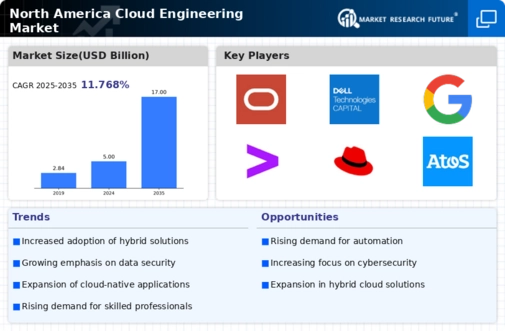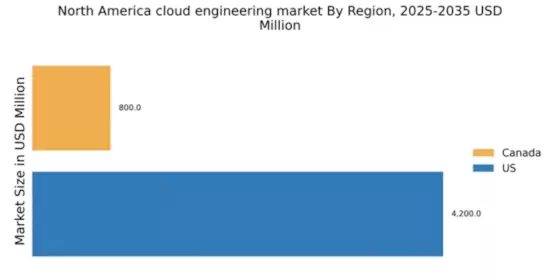Growing Emphasis on Data Analytics
The The North America cloud engineering market is increasingly shaped by a growing emphasis on data analytics. Organizations are recognizing the value of harnessing data to drive decision-making and improve operational efficiency. Cloud platforms provide the necessary infrastructure to store and analyze vast amounts of data, enabling businesses to gain insights that were previously unattainable. The market for cloud-based analytics solutions is expected to reach $100 billion by 2025, indicating a strong trend towards data-driven strategies. This shift is likely to propel investments in cloud engineering, as companies seek to integrate advanced analytics capabilities into their operations. The ability to leverage data effectively is becoming a competitive differentiator, further driving the demand for cloud engineering services.
Increased Focus on Cost Efficiency
Cost efficiency remains a pivotal driver in the cloud engineering market in North America. Organizations are increasingly recognizing the financial benefits of migrating to cloud-based solutions, which often result in reduced operational costs. By leveraging cloud engineering, companies can minimize their capital expenditures on hardware and maintenance, shifting instead to a pay-as-you-go model. This transition is particularly appealing in a competitive landscape where cost management is paramount. Recent statistics suggest that businesses can save up to 30% on IT costs by adopting cloud solutions. As a result, the emphasis on cost efficiency is likely to continue influencing investment decisions in cloud engineering, as firms strive to enhance their financial performance while maintaining technological advancement.
Rising Demand for Scalable Solutions
The The North America cloud engineering market is experiencing a notable surge in demand for scalable solutions. Organizations are increasingly seeking cloud services that can adapt to their evolving needs, particularly as they expand operations. This trend is driven by the necessity for flexibility in resource allocation, enabling businesses to manage workloads efficiently. According to recent data, the market for cloud services is projected to reach approximately $500 billion by 2026, reflecting a compound annual growth rate (CAGR) of around 20%. This growth indicates a robust appetite for scalable cloud engineering solutions, as companies aim to optimize their IT infrastructure while minimizing costs. The ability to scale resources up or down in response to fluctuating demands is becoming a critical factor in the decision-making process for enterprises, thereby propelling the cloud engineering market forward.
Expansion of Remote Work Capabilities
The The North America cloud engineering market is significantly influenced by the expansion of remote work capabilities. As organizations adapt to a more flexible workforce, the need for robust cloud solutions that support remote collaboration has intensified. Cloud engineering facilitates seamless access to applications and data from any location, thereby enhancing productivity and employee satisfaction. Recent surveys indicate that over 70% of companies plan to maintain remote work options, underscoring the importance of cloud infrastructure in supporting this trend. This shift is likely to drive further investments in cloud engineering, as businesses seek to ensure that their remote work environments are secure, efficient, and scalable. The ongoing evolution of work dynamics is expected to sustain the growth of the cloud engineering market.
Advancements in Cloud Security Technologies
Advancements in cloud security technologies are becoming a crucial driver in the cloud engineering market in North America. As organizations increasingly migrate sensitive data to the cloud, the need for robust security measures has never been more pressing. Innovations in encryption, identity management, and threat detection are enhancing the security posture of cloud services. According to industry reports, spending on cloud security solutions is projected to exceed $30 billion by 2025, reflecting a growing recognition of the importance of safeguarding digital assets. This focus on security is likely to influence cloud engineering practices, as companies prioritize the implementation of secure architectures and compliance with regulatory standards. The ongoing evolution of security technologies is expected to play a pivotal role in shaping the future landscape of the cloud engineering market.


















Leave a Comment